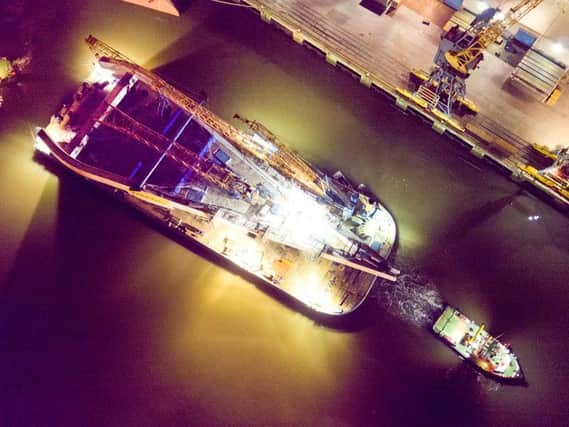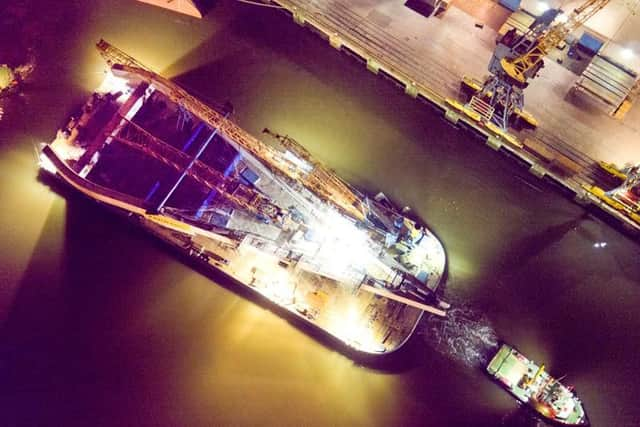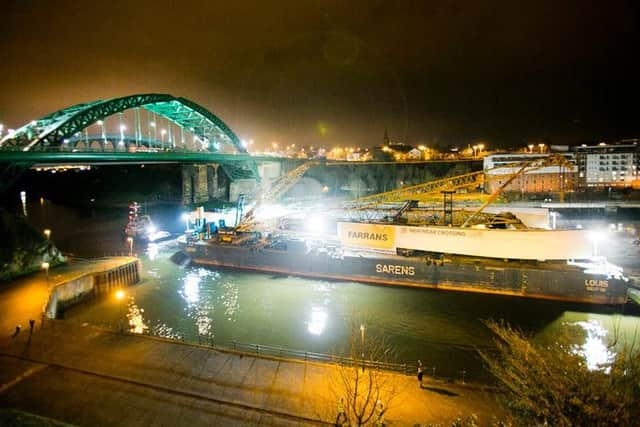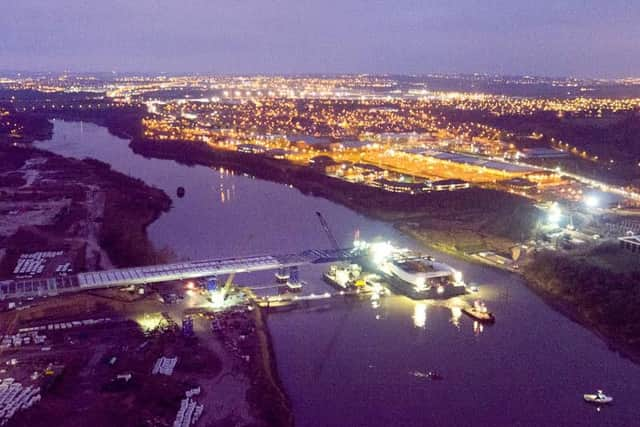Amazing footage as the New Wear Bridge pylon sails into Sunderland


The striking white structure, which will form the focal point of the New Wear Crossing, left Greenwells Quay at the Port of Sunderland at about 5am today and arrived on site at 7am.
It took just two hours for the barge, Louis, which carried the pylon, to snake her way along the three-mile stretch of the River Wear to the site between Pallion and Castletown in the city, where the new bridge is being constructed.


Advertisement
Hide AdAdvertisement
Hide AdShe travelled under the Wearmouth Bridge, passed the Stadium of Light – home of Sunderland AFC – before negotiating the tight corner at Deptford Bend, and finally moving under the Queen Alexandra Bridge, before making her way to site.
On arrival, Louis berthed in the middle of the river next to the cofferdam, close to the location where the pylon will be raised into place in a few weeks’ time.
The project team had carefully planned the transportation to coincide with the right tidal and weather conditions, which meant it had to be carried out during the early hours.
Councillor Paul Watson, leader of Sunderland City Council, said: “It’s great to see the pylon now in its final location on the River Wear. A lot of hard work and planning has gone into building the pylon, and getting it to site, and I think we can now begin to imagine just how impressive it will look when it’s raised into position.


Advertisement
Hide AdAdvertisement
Hide Ad“I appreciate that some people may be disappointed that they were unable to watch it being transported up the river, but given that it would have meant people congregating during the early hours in the dark, along the riverbank, the team took the decision not to publicise it in the interest of reducing health and safety risks to the public. That was the right decision and was something that could not be avoided.
“The operation to raise the pylon will be a long process, but much of it will be carried out in daylight hours, so people will definitely have an opportunity to come out and watch then.”
Stephen McCaffrey, project director for Farrans Victor Buyck Joint Venture (FVB), which is delivering the project on behalf of Sunderland City Council, said the transportation of the pylon to site had gone extremely well.
He said: “A lot of work has been carried out on site during the last 18 months in preparation for the arrival on site of the A-frame pylon, so it’s great to get it here and focus on the next phases of the project.


Advertisement
Hide AdAdvertisement
Hide Ad“We needed to transport the pylon during a specific tidal window and unfortunately that meant taking it up the river during the early hours. However, there will be plenty of opportunities for people to see the pylon on site in the weeks and months ahead – particularly when it is raised into place in a few weeks’ time.
“Nothing of this scale has been lifted in this way in the UK since the London Eye was raised in 1999, and it will be quite something to watch, so we will definitely be telling people when that is happening.”
In the coming days, and through a number of stages, the pylon will be rotated 90 degrees in the river and final engineering works carried out to connect the legs of the pylon with the giant concrete tusks that are fixed into the riverbed inside the cofferdam, which will support the A-frame in its final position.
It is expected to take about 24 hours for the pylon to be raised into place, and several weeks to then secure it to the tusks and foundations.


Advertisement
Hide AdAdvertisement
Hide AdThe transportation, and subsequent raising of the pylon, is being carried out by Sarens, a world leader in heavy lifting and engineered transport.
The new bridge will link Castletown to the north of the River Wear with Pallion to the south, and will have dual two-lane carriageways for vehicles, as well as dedicated cycle and pedestrian routes.
It is on track to open in the spring of 2018, and will help attract investment into Sunderland, create new jobs and regenerate land along the River Wear.
It will enhance public transport, as well as significantly improve the important transport links to the city centre and Port of Sunderland from the A19 and A1.